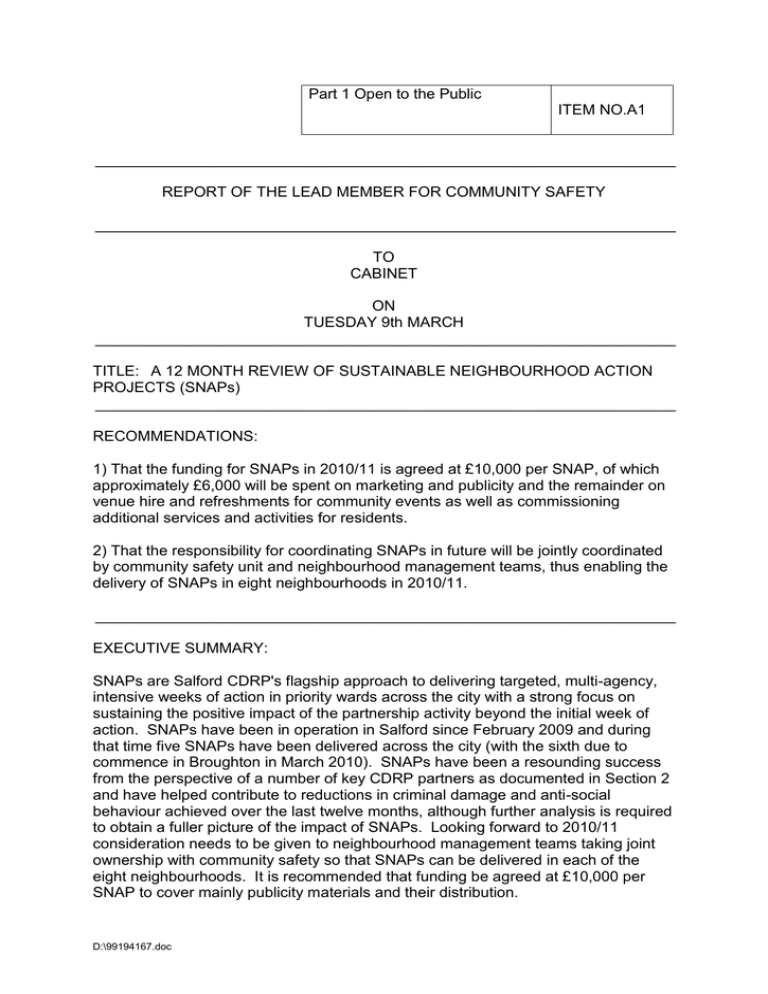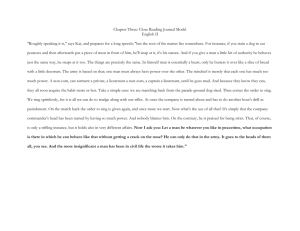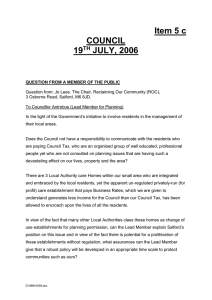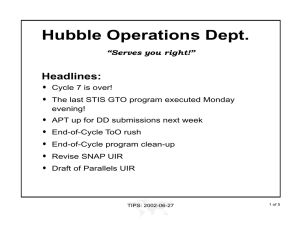Part 1 Open to the Public ITEM NO.A1 ___________________________________________________________________
advertisement

Part 1 Open to the Public ITEM NO.A1 ___________________________________________________________________ REPORT OF THE LEAD MEMBER FOR COMMUNITY SAFETY ___________________________________________________________________ TO CABINET ON TUESDAY 9th MARCH ___________________________________________________________________ TITLE: A 12 MONTH REVIEW OF SUSTAINABLE NEIGHBOURHOOD ACTION PROJECTS (SNAPs) ___________________________________________________________________ RECOMMENDATIONS: 1) That the funding for SNAPs in 2010/11 is agreed at £10,000 per SNAP, of which approximately £6,000 will be spent on marketing and publicity and the remainder on venue hire and refreshments for community events as well as commissioning additional services and activities for residents. 2) That the responsibility for coordinating SNAPs in future will be jointly coordinated by community safety unit and neighbourhood management teams, thus enabling the delivery of SNAPs in eight neighbourhoods in 2010/11. ___________________________________________________________________ EXECUTIVE SUMMARY: SNAPs are Salford CDRP's flagship approach to delivering targeted, multi-agency, intensive weeks of action in priority wards across the city with a strong focus on sustaining the positive impact of the partnership activity beyond the initial week of action. SNAPs have been in operation in Salford since February 2009 and during that time five SNAPs have been delivered across the city (with the sixth due to commence in Broughton in March 2010). SNAPs have been a resounding success from the perspective of a number of key CDRP partners as documented in Section 2 and have helped contribute to reductions in criminal damage and anti-social behaviour achieved over the last twelve months, although further analysis is required to obtain a fuller picture of the impact of SNAPs. Looking forward to 2010/11 consideration needs to be given to neighbourhood management teams taking joint ownership with community safety so that SNAPs can be delivered in each of the eight neighbourhoods. It is recommended that funding be agreed at £10,000 per SNAP to cover mainly publicity materials and their distribution. D:\99194167.doc ___________________________________________________________________ BACKGROUND DOCUMENTS: Community Safety Lead Member Report to Cabinet (14th October 2008) entitled "Proposed changes from Beat Sweep operations to Sustainable Neighbourhood Action Projects (SNAPs)" (Available for public inspection) ___________________________________________________________________ KEY DECISION: YES / NO ___________________________________________________________________ DETAILS: 1 Background 1.1 In 2008, Salford CDRP made a series of recommendations to Cabinet about the redesign of Beat Sweeps operations, with a view to broadening their scope, improving the outcomes for residents and ensuring that improvements were sustained by "developing stronger, more effective partnerships and better informed, more empowered communities". 1.2 A new way of working - known as Sustainable Neighbourhood Action Projects (SNAPs) - was formulated and commenced in Winton in February 2009. To date, five SNAPs have been delivered in Salford, including Langworthy in April, Irwell Riverside in July, Little Hulton in September and Ordsall in December. The following report looks at the achievements to date, lessons learned and makes recommendations for the future success of SNAPs. 2 Achievements To Date 2.1 In the five SNAPs to date, the police have made a total of 68 arrests for a variety of offences. Twenty-nine vehicles have been seized for motoring offences (such as no tax or insurance). Twenty drug warrants have been executed, of which 17 resulted in arrests for drug offences and/or abstracting electricity. Several cannabis farms were found, two of which contained cannabis with a street value of over £20,000. Bus gateway checks identified 137 people travelling without a valid ticket or pass, all of whom received a fine. 2.2 Through the bulky waste collections carried out by Environment Directorate, 118 tonnes of waste has been collected from outside people’s homes and disposed of. This is mainly made up of refrigerators and other white goods, televisions, sofas and other furniture. Graffiti has been removed from 405 sites and litter picking has been carried out in over 200 locations. Forty-nine fixed penalty notices have been issued for a range of offences, including littering and dog fouling. D:\99194167.doc 2.3 The Fire & Rescue Service has carried out home fire risk assessments in the homes of 911 vulnerable residents. In many cases this has involved the fitting of smoke alarms and giving fire safety advice to vulnerable residents. 2.4 Block and estate inspections have been carried out at 14 sites across the city, resulting in improvements to housing stock, open spaces, highways and parks. 2.5 In total over 500 young people have participated in some form of statutory or voluntary youth provision, many of whom doing so for the first time. 2.6 Eleven new alley gate schemes have been introduced, with many more existing schemes repaired or improved as a result of an inspection. 2.7 Numerous community events have been delivered as part of each SNAP, some very well attended (the Escape to Safety installation at Albion High attracted over 250 visitors; the women’s curry and comedy night at St. Sebastian’s Community Centre was a sell out) others not so well attended. Where there was engagement with residents the feedback was generally very positive about SNAPs and the work being carried out in neighbourhoods to improve the local environment and offer accessible activities and services to local residents. Ongoing work is planned with many of the residents that chose to participate in local activities. 2.8 For each SNAP leaflets have been sent to every property in the ward, before, during and after the SNAP. In total, approximately 107,000 leaflets have been printed and distributed. This is in addition to features in the local press, council and partner publications (e.g. Life IN Salford, newsletters, etc.), web sites and via email and other local network distributions. All correspondence has called on residents to have their say on what they would like to see carried out locally and hundreds of residents have put forward suggestions either by email, via the website, by telephone or by text message. 3 Impact of Levels of Crime and Anti-Social Behaviour 3.1 The impact that SNAPs have had on crime and anti-social behaviour in the target wards is difficult to assess at this stage and in most cases is probably too early to tell if there has been a significant and sustained reduction thus far. It is certainly too early to consider the impact in Little Hulton and Ordsall. For the purpose of this report the focus will be on the reports to the police of criminal damage and anti-social behaviour (since these are the type of lowlevel issues we would expect SNAPs to impact upon) in the wards of Winton, Langworthy and Irwell Riverside. 3.2 In Winton in the period March to September 2009, criminal damage fell by 18.5% and anti-social behaviour fell by 33.5% compared with same period in 2008. This compares with citywide reductions of 7.6% and 8.9% respectively over the same period. D:\99194167.doc 3.3 In Langworthy in the period May to September 2009, criminal damage fell by 22.1% and anti-social behaviour fell by 6.3% compared with the same period in 2008. This compares with citywide reductions of 7.9% and 10.3% respectively over the same period. 3.4 In Irwell Riverside in the period August to September 2009, criminal damage fell by 29.9% and anti-social behaviour fell by 10.6% compared with same period in 2008. This compares with citywide reductions of 13.8% and 11.2% respectively over the same period. 3.5 It is difficult to infer too much from these statistics at this time and it is clearly not possible to attribute these trends directly to the SNAPs, but what is clear is that in those wards that have benefited from SNAPs this year, the reductions in criminal damage and anti-social behaviour have mirrored and in some cases far exceeded the downward trend that is being observed across the city. A more comprehensive piece of analysis is required in 2010 with a broader focus on a range of police and partnership data over a longer period of time, in order to draw more concrete conclusions about the impact that SNAPs have had on crime and public perception. 4 Lessons learned 4.1 The amount of correspondence from residents is quite high and currently it is one person’s responsibility to respond to the initial enquiry (and any other follow up correspondence), identify who is the most appropriate service to deal with the problem, action the work and check the work has been carried out. Additional resources will be sought to support this system, otherwise there is a risk that there will be a negative impact on public confidence if emails are not responded to, issues not followed up and work not carried out to an adequate standard. 4.2 The vast majority of enquiries from residents involve environmental issues, but not necessarily problems that are the responsibility of Environment Directorate. Often these issues include problems with the highway, bushes and trees on private land that obstruct the pavement, problems on land managed by a social housing provider, etc. Often the service or team responsible for the land does not have the resources to respond to every issue raised by residents and so the problem is not addressed. Community Payback and the YOS reparations team have helped to address some of the issues in previous SNAPs and work will be carried out to ensure a better response to these challenging issues in 2010/11. 4.3 One of the weaknesses of SNAPs that it is only possible to deliver five operations per year due to the time required to plan for, deliver and evaluate each week of action. If the responsibility for coordinating SNAPs lay with officers working at a neighbourhood level then there would be scope to deliver many more weeks of action across the city. SNAPs could still be supported by centralised staff such as officers in Community Safety and GMFRS. Making these changes would mean that all eight neighbourhoods in Salford would receive a SNAP in 2010/11. The likelihood that the positive work of the D:\99194167.doc SNAP is sustained beyond the initial week of action is likely to be increased if the ownership of the project lay with neighbourhood teams from the outset. 4.4 Attendance at community events has been highest when the individual planning the event has taken an assertive approach when publicising the event. This was particularly evident in the Little Hulton SNAP in which the neighbourhood management team used every opportunity available to them to promote events, including telephone calls, via email and in person. The result was some of the best attended events of any SNAP so far. Where attendance has been low it has often been because the event was not well publicised (or relied too much on the leaflet distribution) or when the event was in the wrong location or at the wrong time. All future SNAPs will seek to avoid repeating these mistakes. 4.5 The cost of each SNAP is approximately £10,000. Around half of this is spent on publicity and associated costs (e.g. leaflets, posters, photography, distribution, etc.) with the remainder used to commission additional services where statutory services either don’t exist or are under-resourced (e.g. Ibulance sexual health bus, theatre and education workshops in schools, etc.), to fund small projects that the community request (e.g. planting schemes, materials to reinstate paths, etc.) or to purchase / hire equipment or materials (e.g. skips, chipping machine, paint, etc.) ___________________________________________________________________ KEY COUNCIL POLICIES: Salford Agreement priority issues ‘Reducing fear of crime’; Salford Community Safety Strategy 2008-11. ___________________________________________________________________ EQUALITY IMPACT ASSESSMENT AND IMPLICATIONS: No adverse implications ___________________________________________________________________ ASSESSMENT OF RISK: LOW ___________________________________________________________________ SOURCE OF FUNDING: Discussions are ongoing to allocate corporate marketing and CDRP budgets to cover the cost of SNAPs in 2010/11. ___________________________________________________________________ LEGAL IMPLICATIONS Supplied by ___________________________________________________________________ FINANCIAL IMPLICATIONS Supplied by ___________________________________________________________________ OTHER DIRECTORATES CONSULTED: All CDRP partners ___________________________________________________________________ D:\99194167.doc CONTACT OFFICER: DAMIAN DALLIMORE TEL. NO. 0161 793 3584 ___________________________________________________________________ WARD(S) TO WHICH REPORT RELATE(S): CITYWIDE ___________________________________________________________________ D:\99194167.doc



